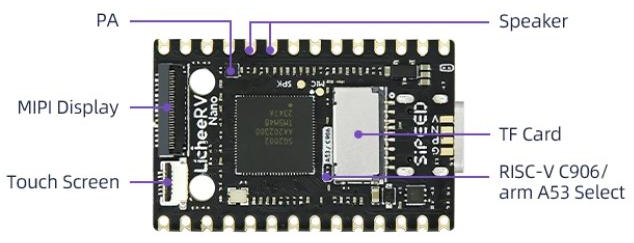MaixCAM MaixPy 播放音频
2024-05-20
更新历史
| 日期 | 版本 | 作者 | 更新内容 |
|---|---|---|---|
| 2024-05-20 | 1.0.0 | lxowalle | 初版文档 |
简介
本文档提供播放音频的使用方法
使用方法
硬件支持情况
| 设备 | 麦克风 | 喇叭 |
|---|---|---|
| MaixCAM | ✅ | ❌ |
| MaixCAM2 | ✅ | ✅ |
| MaixCAM Pro | ✅ | ✅ |
硬件操作

MaixCAM没有内置喇叭,因此需要自行焊接一个功率在1W内的喇叭。喇叭焊接的引脚见上图的Speaker对应的VOP和VON脚。
注:如果MaixCAM在这两个脚上连接了铜柱,则可以直接焊接在铜柱上,为了美观也可以焊接在板子的另一面。
编写代码
播放一个WAV文件
from maix import audio, time, app
p = audio.Player("/root/output.wav")
p.play()
p.volume(80)
while not app.need_exit():
time.sleep_ms(10)
print("play finish!")
步骤:
导入audio、time和app模块
from maix import audio, time, app初始化播放器
p = audio.Player("/root/output.wav") p.volume(80)
- 默认的采样率是48k,采样格式为小端格式-有符号16位,采样通道为1。你也可以像这样自定义参数
p = audio.Player(sample_rate=48000, format=audio.Format.FMT_S16_LE, channel = 1)。目前只测试过采样率48000,FMT_S16_LE格式,和采样通道数为1。 - 如果是
.wav文件,则会自动获取采样率、采样格式和采样通道。 p.volume(80)设置音量为80,范围为[0~100]。
播放音频
p.play()
- 该操作将会阻塞直到写入所有音频数据,但不会阻塞到实际播放完所有音频数据。如果调用
play()后退出了程序,则部分待播放的音频数据可能会丢失。
- 完成
用PCM数据播放
from maix import audio, time, app
p = audio.Player()
with open('/root/output.pcm', 'rb') as f:
ctx = f.read()
p.play(bytes(ctx))
while not app.need_exit():
time.sleep_ms(10)
print("play finish!")
步骤:
导入audio、time和app模块
from maix import audio, time, app初始化播放器
p = audio.Player()
- 注意默认的采样率是48k,采样格式为小端格式-有符号16位,采样通道为1。你也可以像这样自定义参数
p = audio.Player(sample_rate=48000, format=audio.Format.FMT_S16_LE, channel = 1)。目前只测试过采样率48000,FMT_S16_LE格式,和采样通道数为1
打开并播放一个PCM文件
with open('/root/output.pcm', 'rb') as f: ctx = f.read() p.play(bytes(ctx)) while not app.need_exit(): time.sleep_ms(10)
with open('xxx','rb') as f:打开文件xxx, 并获取文件对象fctx = f.read()将读取文件的内容到ctx中p.play(bytes(ctx))播放音频,p是已打开的播放器对象,ctx是转换为bytes类型的PCM数据time.sleep_ms(10)这里有一个循环来等待播放完成,因为播放操作是异步执行的,如果提前退出了程序,那么可能导致音频不会完全播放。
- 完成
非阻塞播放
当做语音助手, 实时通信等场景时通常需要播放音频的过程不能阻塞主线程, 因此可以将Player设置为非阻塞模式,并添加一些应用层代码来支持播放时不阻塞主线程的方法. 参考示例如下:
from maix import audio, app, time
import threading
from queue import Queue, Empty
class StreamPlayer:
def __init__(self, sample_rate=16000, channel=1, block:bool=False):
self.p = audio.Player(sample_rate=sample_rate, channel=channel, block=block)
self.p.volume(50)
zero_data = bytes([0] * 4096)
self.p.play(zero_data)
self.queue = Queue(maxsize=250)
self.t = threading.Thread(target=self.__thread, daemon=True)
self.t.start()
def wait_idle_size(self, size:int):
while not app.need_exit():
idle_frames = self.p.get_remaining_frames()
write_frames = size / self.p.frame_size()
if idle_frames >= write_frames:
break
time.sleep_ms(10)
def __thread(self):
while not app.need_exit():
try:
pcm = self.queue.get(timeout=500)
# wait player is idle
self.wait_idle_size(len(pcm))
self.p.play(pcm)
except Empty:
continue
def write(self, pcm:bytes):
remain_len = len(pcm)
period_bytes = self.p.frame_size() * self.p.period_size()
offset = 0
while remain_len > 0:
write_bytes = period_bytes if period_bytes <= remain_len else period_bytes - remain_len
new_pcm = pcm[offset:offset+write_bytes]
self.queue.put(new_pcm)
remain_len -= write_bytes
offset += write_bytes
def wait_finish(self):
total_frames = self.p.period_count() * self.p.period_size()
while not app.need_exit():
idle_frames = self.p.get_remaining_frames()
if idle_frames == total_frames:
break
time.sleep_ms(10)
if __name__ == '__main__':
stream_player = StreamPlayer()
with open('/maixapp/share/audio/demo.wav', 'rb') as f:
pcm = f.read()
t = time.ticks_ms()
stream_player.write(pcm)
print(f'write pcm data cost {time.ticks_ms() - t} ms')
t = time.ticks_ms()
stream_player.wait_finish()
print(f'write play finish cost {time.ticks_ms() - t} ms')
这个示例里通过block参数将Player对象设置为了非阻塞模式, 因此调用play()方法时不会阻塞主线程
由于内部的缓存大小的限制, 如果一定时间内播放的数据量大于缓冲量时, 还是会阻塞在play方法中, 因此可以通过get_remaining_frames()方法来获取buffer剩余空间的大小, 需要注意该方法返回的单位为帧, 通过frame_size()方法可以将要帧转换为字节
remaining_frames = p.get_remaining_frames() # unit:frame
remaining_bytes = p.frame_size(remaining_frames) # unit: bytes
可以将播放操作放在另一个线程中, 并且可以播放前检查如果剩余空间足够时, 再调用play()来播放, 这样就能保证一定不会阻塞主线程.

 中文
中文